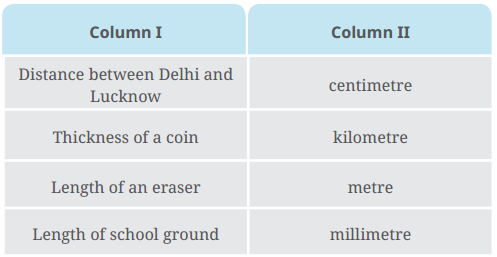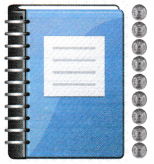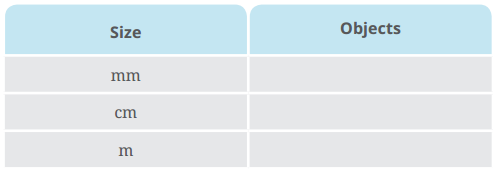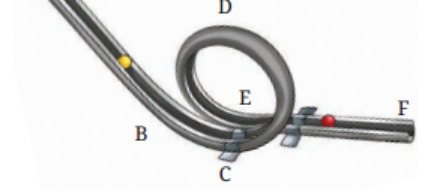How Can You Use Measurement of Length and Motion Class 6 Questions and Answers To Prepare For Exams?
FAQs on NCERT Solutions for Class 6 Science Chapter 5 Measurement of Length and Motion
1. What are NCERT Solutions for Class 6 Science Chapter 5 Measurement of Length and Motion?
NCERT Solutions for Class 6 Science Chapter 5 Measurement of Length and Motion are stepwise, syllabus-aligned answers to all textbook questions, designed to help students practise and understand concepts such as SI units, methods of measuring length, conversion of units, and types of motion as covered in the CBSE 2025–26 curriculum.
2. Which is the standard unit of length in Class 6 Science Chapter 5 NCERT Solutions?
The standard unit of length described in Class 6 Science Chapter 5 is the metre (m), as per the International System of Units (SI).
3. How do NCERT Solutions for Chapter 5 help in converting different units of length?
NCERT Solutions for Class 6 Science Chapter 5 provide practice on converting between millimetres (mm), centimetres (cm), metres (m), and kilometres (km) by offering clear conversion rules, solved examples, and stepwise logic for each type of conversion.
4. What is a reference point and why is it important in measurement, as explained in NCERT Solutions for Class 6 Science Chapter 5?
A reference point is a fixed location or object from which distances are measured. In measurement tasks, setting a reference point ensures accuracy and consistency when finding the distance from one place to another, as described in the NCERT Solutions for this chapter.
5. What are the main types of motion discussed in Class 6 Science Chapter 5 NCERT Solutions?
The main types of motion introduced are:
- Linear motion – motion in a straight line
- Circular motion – motion along a circular path
- Oscillatory motion – motion that repeats to and fro
6. Why should standard units like metre be used for measurement, according to Chapter 5 NCERT Solutions?
Standard units such as the metre are universally accepted, ensuring all measurements are consistent and comparable, which is key for scientific accuracy and communication as explained in Class 6 Science NCERT Solutions.
7. Can you list examples of objects best measured in mm, cm, and m as per the solutions of Chapter 5?
- Millimetres (mm): Thickness of a coin, diameter of a screw
- Centimetres (cm): Length of a pencil, width of a book
- Metres (m): Height of a lamppost, width of a playground
8. According to NCERT Solutions for Class 6 Science Chapter 5, how do you estimate and verify the number of coins required to cover the length of a notebook?
First, measure the diameter of one coin. Then, divide the notebook length by the coin’s diameter for an estimate. To verify, physically align coins edge-to-edge along the notebook and count to confirm the estimation.
9. What practical methods for measuring curved lengths are suggested in Chapter 5 NCERT Solutions?
Use a flexible measuring tape or a piece of string to follow the curve, then straighten the string alongside a ruler to find the actual length. This is particularly useful for circular objects like bottles or tumblers.
10. What materials are NOT suitable for making a metre scale and why, as addressed in the NCERT Solutions?
Stretchable rubber is unsuitable for making a metre scale because it can stretch, leading to inaccurate measurements. Materials like steel, plywood, or sturdy plastic are preferred as they retain exact length.
11. How do NCERT Solutions for Class 6 Science Chapter 5 address common mistakes in unit conversion?
The solutions emphasize:
- Always multiplying or dividing by the correct conversion factor
- Consistently writing units at each calculation step
- Checking whether to convert from a smaller unit to larger (divide) or vice versa (multiply)
12. What if non-standard units (like handspan) are used for measurement as per Class 6 Science NCERT Solutions?
Non-standard units (handspan, cubit, foot) vary from person to person, resulting in inconsistent and unreliable results. Chapter 5 stresses use of standard units like metre for precise, comparable measurements.
13. Explain, as per the solutions, how types of motion can change along a roller coaster path.
On a roller coaster, the ball may travel:
- In linear motion on straight stretches
- In circular motion on loops or bends
- The solution outlines segment-by-segment identification, connecting track shapes to motion types, reinforcing conceptual application.
14. How do NCERT Solutions for Class 6 Science Chapter 5 help in mastering exam-style questions on measurement?
They provide stepwise, CBSE-approved answers for every type of textbook and sample question. Practice with these solutions builds familiarity with exam language and short/long answer formats required in the 2025–26 syllabus.
15. Why is it important to use the correct measuring instrument for a given object, according to the NCERT Solutions for Chapter 5?
Using the appropriate measuring tool (ruler, tape, calliper) ensures measurement accuracy. For example, tiny thicknesses need screw gauges, while room sizes need metre tapes. The solutions stress matching the tool to the size and precision needed for each object.





























